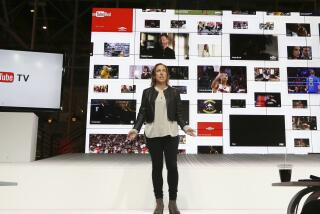YouTube says it’s working to be a safer place for advertisers
While YouTube continues to grow as a destination to watch videos, the company is still working to convince advertisers that the platform is a safe place for their commercials.
Chief Executive Susan Wojcicki told an audience of ad buyers Thursday night at YouTube’s “Brandcast” presentation at Radio City Music Hall in New York that the company has stepped up its efforts to keep ad messages away from videos containing hate speech and other content that violates its guidelines for users.
“This year, we devoted tremendous resources to address these challenges, and we are committed to continuing our investment going forward,” Wojcicki said. “It’s incredibly important to me and to everyone at YouTube that we grow responsibly. There isn’t a playbook for how open platforms operate at our scale. But the way I think about it is, it’s critical that we are on the right side of history.”
Wojcicki said the company is increasing the number of people reviewing content to assure it is appropriate for advertisers.
“We committed to having over 10,000 people across Google by end of year to address violative content,” she said. “And we’re using the latest machine learning technology to apply our policies at scale.”
According to YouTube’s transparency report, the company removed 8.3 million videos that violated its community guidelines in the fourth quarter of 2017.
YouTube — which draws 1.6 billion viewers a month — has been drawing young viewers away from traditional television. It has created self-made stars who have millions of subscribers tuning in to their content. Numerous big name celebrities such as Kevin Hart and Ellen DeGeneres have YouTube channels as well.
But the platform also has faced criticism over its ability to police the content that users upload to the site. Companies have pulled their ads to avoid videos with offensive material or hate speech from white supremacy groups and conspiracy theorists.
YouTube generated public outrage last year after one of its most popular creators, Logan Paul, presented a video of a dead body hanging from a tree in Japan’s Aokigahara forest, which is known as a spot for people to commit suicide.
Despite the crisis, YouTube parent Google remains a dominant force in online advertising. The company’s $35 billion in annual ad revenue accounts for 42% of the digital advertising market, according to eMarketer.
YouTube is attempting to grow by tapping into the $185-billion TV ad market in the U.S.
While ratings for broadcast and cable networks have been slipping, those companies have used their ability to better control their content as a way to hold onto their share of advertising dollars.
Along with better policing of content, YouTube also is trying to position itself as being more like television. That was reflected even in the choice of the Brandcast venue, Radio City Music Hall, which traditionally has been used by NBC for its annual presentation to advertisers.
Wojcicki noted that 7 out of 10 YouTube users are now watching the platform on a TV screen, thanks to the growth of internet-connected televisions and video-streaming devices such as Roku.
She also announced that the company will be selling ads on the cable channels carried on YouTube TV, its over-the-top subscription service that offers a package of broadcast and cable networks for a monthly fee. The service, available in 85% of the country, is aimed at cord-cutters.
Twitter: @SteveBattaglio
More to Read
Inside the business of entertainment
The Wide Shot brings you news, analysis and insights on everything from streaming wars to production — and what it all means for the future.
You may occasionally receive promotional content from the Los Angeles Times.











